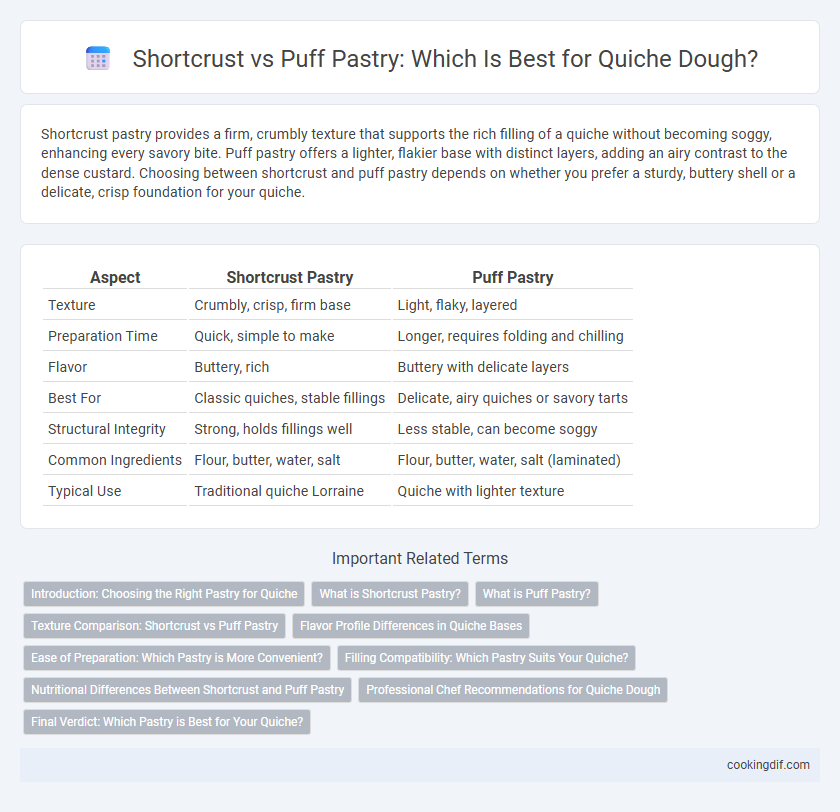Shortcrust pastry provides a firm, crumbly texture that supports the rich filling of a quiche without becoming soggy, enhancing every savory bite. Puff pastry offers a lighter, flakier base with distinct layers, adding an airy contrast to the dense custard. Choosing between shortcrust and puff pastry depends on whether you prefer a sturdy, buttery shell or a delicate, crisp foundation for your quiche.
Table of Comparison
| Aspect | Shortcrust Pastry | Puff Pastry |
|---|---|---|
| Texture | Crumbly, crisp, firm base | Light, flaky, layered |
| Preparation Time | Quick, simple to make | Longer, requires folding and chilling |
| Flavor | Buttery, rich | Buttery with delicate layers |
| Best For | Classic quiches, stable fillings | Delicate, airy quiches or savory tarts |
| Structural Integrity | Strong, holds fillings well | Less stable, can become soggy |
| Common Ingredients | Flour, butter, water, salt | Flour, butter, water, salt (laminated) |
| Typical Use | Traditional quiche Lorraine | Quiche with lighter texture |
Introduction: Choosing the Right Pastry for Quiche
Shortcrust pastry offers a sturdy, crumbly base that holds rich quiche fillings without becoming soggy, making it ideal for classic quiches. Puff pastry provides a lighter, flakier texture that adds an airy contrast but may absorb moisture differently, affecting the quiche's structural integrity. Selecting between shortcrust and puff pastry depends on the desired balance between firmness and flakiness in the final quiche.
What is Shortcrust Pastry?
Shortcrust pastry is a type of dough made from flour, fat (usually butter), and a small amount of water, resulting in a tender and crumbly texture ideal for quiche bases. It provides a sturdy yet delicate crust that holds fillings well without becoming soggy, making it a preferred choice for traditional quiche recipes. Unlike puff pastry, shortcrust pastry is less flaky but offers a richer, buttery flavor that complements savory quiche fillings.
What is Puff Pastry?
Puff pastry is a light, flaky dough made by layering butter and dough through repeated folding and rolling, creating dozens of delicate layers that rise and separate during baking. This pastry provides a crisp, airy texture ideal for quiche, offering a more buttery and flaky alternative to the denser, crumbly shortcrust dough. Its layered structure enhances the overall mouthfeel, making puff pastry a popular choice for quiche recipes that emphasize a delicate and tender crust.
Texture Comparison: Shortcrust vs Puff Pastry
Shortcrust pastry offers a crumbly and buttery texture that provides a sturdy base, ideal for holding rich quiche fillings without becoming soggy. Puff pastry delivers a light, flaky, and layered crust that adds a delicate crispiness but may lack structural support for heavier ingredients. Choosing between shortcrust and puff pastry depends on whether a firm, tender base or a crisp, airy shell better complements the quiche's texture.
Flavor Profile Differences in Quiche Bases
Shortcrust pastry provides a rich, buttery flavor and a dense, crumbly texture that complements the savory custard filling of quiche by adding depth and a slightly nutty undertone. Puff pastry offers a lighter, flakier texture with a delicate, buttery taste that creates a contrast to the creamy filling, enhancing the overall mouthfeel without overpowering the subtle flavors. Choosing between shortcrust and puff pastry alters the quiche's flavor profile, where shortcrust delivers a robust base, while puff pastry provides an airy, crisp foundation.
Ease of Preparation: Which Pastry is More Convenient?
Shortcrust pastry offers greater ease of preparation for quiche dough due to its simple combination of flour, butter, and water, requiring minimal rolling and shaping skills. Puff pastry demands precise folding and chilling to achieve its signature flaky layers, often making it more time-consuming and technique-sensitive. For convenience and quicker assembly, shortcrust pastry is the preferred option in most quiche recipes.
Filling Compatibility: Which Pastry Suits Your Quiche?
Shortcrust pastry provides a sturdy, buttery base that supports rich, dense quiche fillings like cheese, bacon, and vegetable mixtures without becoming soggy. Puff pastry offers a light, flaky texture ideal for lighter fillings such as spinach and ricotta or salmon, adding a delicate contrast to creamy custards. Choosing the right pastry depends on the moisture content and weight of the filling, ensuring optimal texture and flavor balance in the finished quiche.
Nutritional Differences Between Shortcrust and Puff Pastry
Shortcrust pastry typically contains fewer calories and less fat compared to puff pastry, making it a lighter option for quiche dough. Puff pastry is rich in butter layers, resulting in higher saturated fat and calorie content, which can impact heart health if consumed frequently. Choosing shortcrust over puff pastry can reduce overall fat intake while still providing a crisp and sturdy base for savory quiches.
Professional Chef Recommendations for Quiche Dough
Professional chefs often recommend shortcrust pastry for quiche dough due to its sturdy, buttery texture that perfectly supports rich fillings without becoming soggy. Shortcrust's dense structure allows for a crisp, tender base that contrasts well with creamy custards, enhancing the overall eating experience. Puff pastry, while flaky and light, can overwhelm delicate quiche fillings and may not provide the same reliable structural integrity needed for professional presentation.
Final Verdict: Which Pastry is Best for Your Quiche?
Shortcrust pastry offers a sturdy, buttery base that holds the quiche filling well and provides a crisp, crumbly texture ideal for savory ingredients. Puff pastry creates a lighter, flaky crust with multiple layers that add a delicate crunch but may become soggy faster under moist fillings. For a classic, dependable quiche, shortcrust is the best choice, while puff pastry suits those seeking a more elegant presentation with a lighter texture.
Shortcrust vs puff pastry for quiche dough Infographic

 cookingdif.com
cookingdif.com